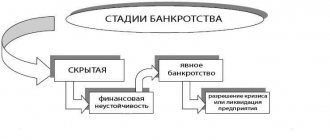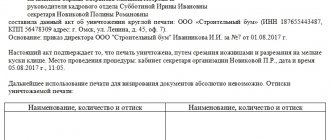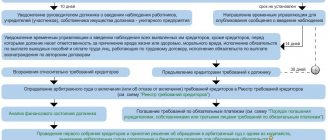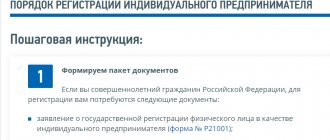Essentially, this event is the primary step towards confirming the financial insolvency of a legal entity. It is also considered the most important of the five stages approved by law. It is the observation process that makes it possible to determine the future of a registered organization. After all, the prospects in this situation are ambiguous: liquidation or the likelihood of recovery. In today’s article, we will figure out how long the monitoring procedure is introduced in the event of bankruptcy of a legal entity, for what purpose and how it is carried out.
- Circumstances of introduction: when and why
- Input conditions
- What is the purpose of the observation procedure?
- Order of conduct
- Which manager is appointed to carry out the monitoring procedure?
- Duration of observation activities
- Restrictions for the debtor
- Rights and obligations of observation participants
- Advantages and disadvantages of observational activities
- What is the end of observation as a bankruptcy procedure: consequences
Circumstances of introduction: when and why
This operation can be initiated only after the formation and submission of a claim to a judicial authority for recognition of a legal entity. persons insolvent. The direct initiator may be the enterprise itself (or, alternatively, its representative) or the lender. The process starts when the debtor does not repay the debt, exceeding a total of 300,000 rubles for more than 3 months.
Input conditions
The monitoring exercise is carried out, among other things, to eliminate the possibility of the organization being unlawfully declared bankrupt. When understanding what the purpose of the monitoring procedure is and how to delay the introduction under bankruptcy law, it is important to know that the insolvency application is carefully checked. The grounds specified therein must be fully consistent with the existing state of affairs of the company. Financial documents of a legal entity are reviewed within 5 calendar days from the date of receipt of the application for recognition of insolvency.
Initiating an operation with selfish intentions, such as concealing facts of property fraud or unwillingness to fulfill obligations under existing agreements, is considered illegal. For providing false information, the head of the enterprise may be subject to criminal liability. In a situation where his unlawful actions caused an increase in debt or entailed other consequences.
Observation actions will not be carried out if the organization has already activated its own liquidation process. There is no point in taking any action in this situation. After all, the task of carrying out an event to declare a legal entity bankrupt is not the sale of its property, but its abolition.
Bankruptcy of individuals
from 5000 rub/month
Read more
Services of a credit lawyer
from 3000 rubles
Read more
Legal assistance to debtors
from 3000 rubles
more
Write-off of loan debts
from 5000 rub/month
More details
What is the purpose of the observation procedure?
Observation actions begin approximately 30 days from the date of filing the statement of claim. When implementing them, the judicial authority has the following intentions:
- Analyze applications submitted by creditors, determine the amount of debt and create lists.
- Preserve company-owned property whenever possible.
- Determine the scope of its activities for the enterprise or terminate its operation.
- Ensure the preservation of the organization's status in order to enable it to pay off its obligations.
- Based on the likelihood of payments, make a decision on liquidation.
The above points will help you understand what the monitoring procedure means during bankruptcy and conducting a financial analysis of the debtor briefly, the goals and timing of its implementation. When carrying out monitoring activities, they collect information about existing debts, draw up a register of claims and organize a meeting of lenders.
Bankruptcy proceedings - the last stage of bankruptcy
If the company was unable to eliminate its accounts payable during the above-described bankruptcy insolvency procedures, the final stage begins - bankruptcy proceedings. From this moment on, the organization is bankrupt. The purpose of bankruptcy proceedings is to eliminate the debtor enterprise and satisfy the creditor's claims through the sale of the organization's property. This stage is controlled by the bankruptcy trustee and lasts six months. One of the important tasks of bankruptcy proceedings is a complete inventory and assessment of the value of the company’s property.
This property is the bankruptcy estate, from which the claims of creditors are proportionately satisfied. All this is recorded in the bankruptcy trustee’s report. Based on this report, after all requirements are satisfied, a court decision is made to complete bankruptcy proceedings. This determination is sent by the bankruptcy trustee to the state registration authorities, which make a record of the termination of the organization’s activities in the Unified State Register of Legal Entities. It is worth remembering that bankruptcy insolvency proceedings in the form of bankruptcy proceedings are a last resort measure for collecting accounts payable. Thus, it can be understood that the legislation provides for a number of scenarios for bankruptcy procedures, ranging from full restoration of financial solvency to criminal liability. If it is impossible to restore solvency, the law guarantees judicial protection of the creditor's interests by collecting the organization's debts at the expense of its property.
Thus, bankruptcy, the procedures of which are determined based on the existing situation of the organization, allows it to begin to function normally and restore its financial position. In addition, this is beneficial for creditors, because the debtor will be able to pay off all his debts.
Order of conduct
The insolvency operation begins with a decision of the judicial authority. To do this, a series of step-by-step actions are performed. At the preparation stage, the materials attached to the case are examined in detail, and the validity of the claims made by the claimant is checked. If, based on the results of the consideration, an affirmative decision is made, the arbitration judge sends a notice to the applicant that the application is recognized as justified. This means that proof of insolvency is indeed necessary. The monitoring procedure is carried out with the participation of a manager, who is appointed to conduct it by the court. The question of how exactly payment for its activities will be made is decided in advance.
In some cases, selecting a candidate to manage a company during the observation period becomes difficult. This happens due to the lack of a suitable candidate. In this situation, the consideration is postponed. The maximum deferment time is 2 weeks.
The assigned activities do not interfere with the functioning of the organization and its management team. The planned transactions are carried out in the same manner, only under the control of a temporary manager. There are several restrictions:
- The enterprise cannot reorganize or form new branches.
- Legal a person is prohibited from issuing securities and reselling company shares.
- There should be no changes in the constituent composition.
- It is not possible to transfer dividends to shareholders.
- Agreements on property issues are limited to 5% of the book value of the legal entity’s assets.
In addition, during the introduction of supervision by an arbitration court during a bankruptcy procedure, the consequences of which are already known, the following organizational issues are present:
- Payments to creditors are stopped for a certain period, which makes it possible to assess the actual state of the legal entity.
- Debt collection proceedings are added to the general case.
- The seizure of the property is lifted.
- All documentation is transferred to the temporary manager.
- Shareholders are deprived of the right to withdraw from the company.
According to Art. 28 of the Federal Law about the initiation of an operation to declare the insolvency of an organization must be notified: creditors, counterparties, tax authorities, bailiffs and other authorities that control the work of the company.
The court-appointed manager is obliged to analyze the financial situation of the legal entity and, based on the results of the analytical study, propose effective ways to eliminate problems. For this purpose, a report is generated and a plan for subsequent actions is approved - moving the operation to other levels, reaching a settlement agreement.
Introduction of observation
The introduction of supervision involves the selection of a temporary manager, who is appointed through the court and acts together with the leaders of the organization.
The court decision on the use of surveillance must include the following information:
- recognition of creditor claims as legitimate and the need to apply the procedure;
- appointment of a temporary manager;
- the amount of the temporary manager's salary and the source of his financing.
If a suitable candidate for the role of temporary manager is not found, a court decision is made to postpone the consideration of the issue of his appointment (terms - no more than fifteen days).
The decision to monitor and appoint a temporary manager is subject to immediate implementation and may be appealed.
The use of surveillance is not a basis for removing the director of an organization or terminating the activities of other management bodies. They can continue to perform their function with some restrictions.
The rights and responsibilities of the temporary manager include:
- obtaining any (including confidential) information about the functioning of a legal entity;
- submitting reports to the court on your activities (upon completion of the procedure);
- identification of creditor claims.
After surveillance is established, information about the receipt by the court of an application to declare the company bankrupt is transmitted to credit institutions, the court, the chief bailiff, tax and other authorities.
With the written approval of the temporary manager, the management bodies of the debtor organization may enter into types of transactions related to:
- with the disposal of the organization’s property, the value of which does not exceed 5% of the value of assets on the date of implementation of surveillance;
- with the receipt or provision of loans, provision of guarantees, assignment of claims, redirection of debt, as well as with the introduction of trust management of the bankrupt’s property.
This list may be increased by a court decision, i.e. the court may impose a ban on concluding any transaction without the approval of the temporary manager.
Decisions that cannot be made by the management body or temporary manager:
- on reorganization or closure of a legal entity;
- on the creation of an organization or participation in other legal entities;
- on the formation of a branch or representative office;
- on the payment of dividends or redistribution of profits between participants of the legal entity;
- on the placement of securities (except for shares) by a legal entity;
- about withdrawal from the membership of a legal entity;
- on participation in associations, unions and other associations of legal entities.
From the moment surveillance is introduced, any restrictions on the disposal of the organization’s property (including arrests) can only be applied as part of the bankruptcy process.
Do you need to liquidate an enterprise or business? Read the article - liquidation and reorganization of JSC.
You can download the statement of claim for liquidation of the fund using this link.
Which manager is appointed to carry out the monitoring procedure?
The independent expert for this role is determined by the decision of the arbitration judge. Its position makes it possible to freely access the transaction database and any documents of the enterprise. All information that can help pay off debt obligations is at his disposal.
The period of activity of the temporary manager is limited to a specified period, the duration of which is determined by the judicial authority. Observational activities are carried out under his direct control. Upon completion of the operation, he transfers the available materials and a report on his own work to the court. The results of an analytical study of the company’s financial capabilities, rational proposals for the further functioning of the legal entity, reasonable prospects for restoration - all this information must be presented to the judge. Which corresponds to the rights and obligations of the temporary manager in the monitoring procedure, for which he receives remuneration.
Thus, the independent expert is obliged to do the following:
- Control decisions made by the management team of the enterprise.
- Analyze the state of finances.
- Compile a list of lenders and organize their meeting.
- Based on the results of the inspection, prepare a list of recommendations and a conclusion.
To determine the total debt of the company to the persons providing it with credit, the supervisory director draws up a register in which he notes the claims of creditors. Based on the collected data, depending on the total amount of debt, he determines the share of votes. The inventory is created throughout the operation. At the same time, representatives of credit institutions who filed their claims within 1 month from the date of introduction of observation measures have the right to participate in the first meeting.
To streamline the steps of the observational study procedure, a meeting must be held at least 10 days before its completion. During the discussion, decisions are made regarding the further operation of the enterprise. An independent expert presents the results of the inspection and makes recommendations for solving existing problems. At the same time, creditors may agree with the advisory instructions or challenge their implementation. The results are summed up based on the voting results, which is noted in the protocol of the observation activities. The temporary manager must send the document, drawn up in accordance with all the rules, to the judicial authority.
The manager is well aware of the nature of Bales' standardized observation procedure. Working with people who are often aggressive during a discussion is his direct responsibility during a general discussion.
When convening a meeting, two leading issues are considered:
- What specific actions are applicable in relation to the debtor (implies a transition to another level of recognition of insolvency or cancellation of the operation).
- If it is not possible to reach a settlement agreement and the process is transferred to another stage, the person responsible for its implementation is determined by the advantage of the number of votes.
Also at the meeting, a committee of lenders is formed, which is subsequently charged with representing the interests of all creditors. In a situation where the claim is filed before the introduction of the monitoring procedure, representatives of the credit company are not present at the first meeting.
Consequences of the monitoring procedure in case of bankruptcy of a legal entity
For the debtor, the monitoring stage is of decisive importance, since it depends on the competent actions of the manager , on his vector of focus (de facto actions can be aimed at restoring the activity of the enterprise or finally bringing it to bankruptcy), as well as on the assessment of the manager and The verdict of the meeting of creditors depends on :
- whether the organization’s activities will be terminated and the next stage of the bankruptcy procedure will begin;
- or an amicable agreement will be reached between the debtor and the lenders.
In the latter case, the following are determined:
- terms of debt repayment;
- order of payments;
- the procedure for mutual settlements;
- offset of debt with products, or property, etc.
A decision may also be made to begin the next stage of bankruptcy - rehabilitation, external administration or bankruptcy proceedings.
Duration of observation activities
The maximum duration of the stage from the moment the statement of claim is accepted by the judicial authority until the results of the work of an independent expert are transferred is 7 months. Another one is required to check the objectivity of the stated grounds and additional information, as well as to select a suitable applicant. Additionally, the operation itself can take six months or even more, as practice shows.
If you pay attention to the average statistical data, when submitting reports on the non-standardized observation procedure, the time frame for bankruptcy is approximately 20 weeks. A reduction in the period becomes possible when the insolvent legal entity and the lenders succeed in reaching a settlement agreement. The necessary documentation is completed and observation activities are terminated earlier.
How does the procedure work?
Monitoring is established from the moment the court receives the creditors' application and based on the results of the judicial review of the legality of the claims.
Main components of the procedure:
- ensuring the safety of property;
- filling out the register of creditor claims;
- holding a meeting of creditors;
- suspension of enforcement documents on property penalties;
- a ban on allocating the share of one of the shareholders of a legal entity;
- prohibition on a legal entity making a decision on bankruptcy, etc.
Article 71 of the Federal Law on Bankruptcy states that in order to participate in the first meeting, lenders must put forward their demands within thirty days from the date of publication in the media of a message about the establishment of a monitoring procedure.
If such claims were made after thirty days, they are considered by the arbitration court after the commencement of the bankruptcy procedure following the supervision.
To submit objections, the debtor is given 15 days from the expiration of the period for submitting creditor claims.
If there are objections, the court checks the validity of the requirements and makes a decision to enter or refuse to enter them into the register. This determination can be appealed.
If necessary, the court may oblige the temporary manager to postpone the date of the first meeting of creditors until the consideration of the claims is completed.
The date of the first meeting is set by the temporary manager, who also sends out notices to all lenders. The first meeting is held at least ten days before the termination of the observation procedure.
At the first meeting, issues such as:
- the need for material improvement of the organization;
- establishment of external management;
- petition to the court to declare the organization bankrupt;
- commencement of bankruptcy proceedings;
- formation of a committee of lenders;
- establishing the powers of the committee of lenders;
- additional requirements for the bankruptcy trustee;
- appointment of a registrar;
- consideration of other issues.
Decisions at the first meeting are made by a majority vote of lenders, tax and other authorities. In case of bankruptcy of monopolized enterprises of the fuel and energy complex, a decision is made at the meeting to send an application to the court to declare the legal entity bankrupt and to begin bankruptcy proceedings with at least ¾ votes.
The first meeting of creditors is an extremely important event for the organization. Its task is to determine the future fate of the company by lenders.
The temporary manager provides creditors with information about the financial position of the legal entity and outlines the prospects (or impossibility) of resuming solvency. However, the proposals of the temporary manager are advisory in nature and are not uncontestable for lenders.
Creditors can form their own position regarding the possibility of financial recovery of a legal entity, which will differ from the proposals of the temporary manager.
The minutes of the first meeting are sent by the temporary manager to the court a maximum of five days after the meeting. Creditor claims are sent to the court, the debtor organization and the temporary manager.
The requirements are accompanied by a judicial act or other documentation certifying the legality of such requirements. After consideration of creditor claims, the court determines the grounds for entering such claims into the register.
Find out what the liquidation of a unitary enterprise entails. What is the procedure for closing a representative office of a foreign company in Russia, read this link.
All about the liquidation of a credit institution at this address.
Restrictions for the debtor
If there is debt as a result of which an insolvency operation was initiated, possible actions on the part of the debtor are limited. Thus, an enterprise cannot:
- Conclude property agreements if their value exceeds the established 5% of total assets.
- Provide or receive a loan, transfer debt obligations, act as a guarantor or guarantor.
- Change the legal form of business activity.
- Create or disband branches.
- Pay dividends to shareholders.
- Issue securities, buy/sell shares.
- Act as a participant in holdings, associations, unions, etc.
The debtor may file a complaint against the ruling to introduce a monitoring procedure if it was not introduced according to the rules established by law.
Bankruptcy of individuals
from 5000 rub/month
Read more
Services of a credit lawyer
from 3000 rubles
Read more
Legal assistance to debtors
from 3000 rubles
more
Write-off of loan debts
from 5000 rub/month
More details
Activities of the enterprise during the observation period
At this stage, the organization conducts its normal activities, works under previously concluded contracts and even has the right to enter into new ones (while notifying the counterparty of the presence of surveillance).
For low- and mid-level employees, virtually nothing changes in normal work; Also, any employee has the right to apply for resignation. The rights and opportunities are limited exclusively to the director and founders of the enterprise. For example:
- they do not have the right to make a decision on the reorganization of the company, on the opening of new branches or other organizations;
- they do not have the right to organize the company’s entry into any unions, associations, etc.;
- they do not have the right to initiate additional issue of shares and other securities;
- dividends cannot be transferred to founders and shareholders;
- the composition of the founders must remain unchanged;
- transactions related to property assets can be concluded only if their amount is no more than 5% of the book value of the property of the debtor enterprise.
In addition, without the approval of the temporary manager, managers do not have the right to make any decisions related to the issuance or receipt of loans, credits, financial guarantees, etc.
Rights and obligations of observation participants
Participants in the observation activities are:
- Legal entity-debtors.
- Lenders.
- Independent expert (temporary manager).
How their actions are regulated at the legislative level can be seen in the table below:
| Subjects | Has the right | Must |
| Debtor |
|
|
| Lender |
|
|
| Expert |
|
|
Understanding what costs are typical for challenging transactions in the monitoring procedure and a sample request for an extension, it is easy to understand that this operation is quite complex, requiring serious time and financial costs. Only if the participants strictly observe their rights and obligations will it be possible to avoid the emergence of disputes and further proceedings in court.
Enshrinement in law
The necessity and mandatory nature of the monitoring procedure in case of bankruptcy of a legal entity is established by the requirements of Federal Law No. 127-FZ of October 26, 2002 “On Insolvency (Bankruptcy)”. For 2020, the latest current version of the law includes changes made on July 3, 2020 by Federal Laws No. 304 and No. 360.
The Law “On Insolvency (Bankruptcy)” describes in detail all aspects related to bankruptcy:
- measures to prevent bankruptcy;
- features of consideration of bankruptcy cases in arbitration courts;
- measures for reorganization (financial recovery) of the enterprise;
- rights and obligations of the debtor and creditors;
- the intricacies of carrying out all stages - monitoring, external control, financial recovery, bankruptcy proceedings and reorganization (a separate Chapter of the said Law is devoted to each of these stages).
The observation phase is described in Chapter IV, in articles Nos. 62-75. These articles define:
- the procedure for implementing this measure;
- its conditions and consequences for the debtor;
- rights and obligations of the temporary manager;
- the procedure for working with creditors, in particular, the privileges and scope of authority of the first meeting of creditors.
Advantages and disadvantages of observational activities
The advantages of their implementation include the following points:
- The arbitration court can correctly assess the factors explaining the need to declare insolvency.
- The defendant-debtor is guaranteed to receive state protection.
Of the minuses, it should be noted that:
- The activities of the enterprise are limited.
- Some transactions cannot be carried out.
- The price of business is getting lower.
In any case, each individual situation is individual and requires separate consideration.







